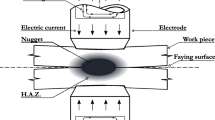Abstract
When the welding materials, joint configuration, welding variables, and level settings of the welding parameters are not suitable and appropriate, the weld bead does not achieve optimum weld strength and ductility, resulting in damage and broken down on the welded joint when load/pressure is applied. The goal of this study is to present optimal process parameters for attempting to improve the mechanical properties of the weld joint. The experimental analysis methodology was used in this study. The goal of this study is to enhance welding process variables for dissimilar steel metal joints made of duplex stainless steel (DSS) to ASTM/UNS S32205 and erosional steel CORTEN-A to ASTM A242. Such a dissimilar metal joint finds use in the transportation sector, particularly in the construction of rail cars. The square butt joint between two 2-mm-thick sheets was investigated using the gas metal arc welding (GMAW) process with CO2 as the shielding gas and flux cored wire of grade 309L as the filler material. The L9 Taguchi array was used to optimize the tensile strength of the resulting weld joint, which was the desired quality characteristic. GMAW process parameters such as voltage, wire feed rate, and welding speed are optimized at three levels. Using ANOVA, the effects of each factor have been studied. It was found that the ideal set of parameters exists, and that the voltage is the most crucial factor. A confirmation test was performed to validate the results, and it was accompanied by a figure and tables.









Similar content being viewed by others
References
Gotkowski P et al (2013) Duplex steel welding in construction of railway vehicles. Welding International-2013, selected from Bileteyn Instytytu Spawalinictiva 2011(5):43–47
Kah P and Martikainen J, (2012) “Current trends in welding processes and materials: improve in effectiveness”, Rev Adv Mater Sci Lappeenranta University of Technology, Lappeenranta, Finland, pp. 189–200
Mendoza B, Maldonado Z, Albiter H, Robles P (2010) Dissimilar welding of superduplex stainless steel/HSLA steel for offshore applications joined by GTAW. Engineering 2(7):520–528. https://doi.org/10.4236/eng.2010.27069
Anoop CA, Kumar P (2013) ‘Application of Taguchi methods and ANOVA in GTAW process parameters optimization for aluminium alloy 7039. Int J Eng Innov Technol (IJEIT) 2(11):54–58
Lenin N et al (2010) Process parameter optimization in arc welding of dissimilar metals. Thammasat Int J Sci Technol 15(3):1–7
Taban E et al (2008). “ Evaluation of dissimilar welds between ferritic stainless steel modified 12% Cr and carbon steel S355”, Weld Res J Am Weld Soc 291S-297S
Westin EM (2010), ‘Microstructure and properties of welds in the lean duplex stainless steel LDX 2101, Scientific thesis for the degree of Doctorate of Engineering Royal Institute of Technology, Department of Materials Science and Engineering: Stockholm, pp 10–59
Tewari SP et al (2010) Effect of welding parameters on the weldability of materials: improve in effectiveness. Int J Eng Sci Technol 2(4):512–516
Sapakal SV, Telsang MT (2012) Parametric optimization of MIG welding using Taguchi design method. Int J Adv Eng Res Stud 1(4):28–30
Suban M, Tusek J (2001) “Dependence of melting rate in MIG/MAG welding on the type of shielding gas used.” J Mater Sci Process Technol: Weld Inst Lubljana Slovania 185–192:119
Sukhomay P et al (2009) Optimization of quality characteristics parameters in a pulsed metal inert gas welding process using grey-based Taguchi method. Int J Adv Manuf Technol 44:1250–1260
St Weglski M et al (2008) Effect of welding current on metal transfer in GMAW. International Science J World Acad Mater Manuf Eng 33(1):49–56
Labanowski J (2007) Mechanical properties and corrosion resistance of dissimilar stainless steel welds. Int Sci J Polish Acad Sci Arch Mater Sci Eng 28(1):27–33
Zhang XY et al. (1977) “Study on the microstructure, mechanical properties and corrosion resistance of a novel HSLA steel”, National High Technical Research and Development Programme of China (No.2003AA331020)
ISO 15609-1:2019 (2019) Specification and qualification of welding procedures for metallic materials. Retrieved from https://www.iso.org/ru/standard/75556.html
Acknowledgements
The authors are appreciative that my family provided financial support for this research. Additionally, I would like to thank the Mizan-Tepi University Mechanical Department for allowing me to use their welding equipment.
Author information
Authors and Affiliations
Contributions
GT conducted a review, experimental result and data, and analyzed theoretical data. The author, Fasil Kebede Tesfaye, provided comments and checked the paper’s quality.
Corresponding author
Ethics declarations
Competing interests
The author declares no competing interests.
Additional information
Publisher's note
Springer Nature remains neutral with regard to jurisdictional claims in published maps and institutional affiliations.
Rights and permissions
Springer Nature or its licensor (e.g. a society or other partner) holds exclusive rights to this article under a publishing agreement with the author(s) or other rightsholder(s); author self-archiving of the accepted manuscript version of this article is solely governed by the terms of such publishing agreement and applicable law.
About this article
Cite this article
Tesfaye, F.K. Parameter optimizations of GMAW process for dissimilar steel welding. Int J Adv Manuf Technol 126, 4513–4520 (2023). https://doi.org/10.1007/s00170-023-11356-7
Received:
Accepted:
Published:
Issue Date:
DOI: https://doi.org/10.1007/s00170-023-11356-7




